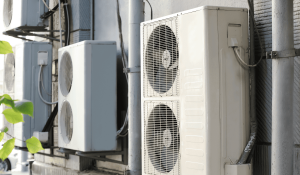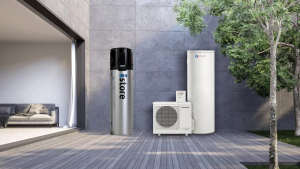Definition of Geothermal Heating
Geothermal heating is a renewable energy source that harnesses the Earth’s natural heat to provide warmth in residential, commercial, and agricultural settings. This type of heating system works by transferring heat from below the Earth’s surface into a building or greenhouse. The process involves utilizing geothermal heat pumps and underground systems to extract and distribute heat.
Brief History of Geothermal Heating
Geothermal energy has been used for thousands of years, dating back to ancient Roman times. The Romans built their baths over natural geysers and hot springs, using the water for heating purposes.
In the 20th century, scientists began to explore ways to harness geothermal energy on a larger scale. Iceland was one of the first countries to invest in geothermal power plants in the 1950s, and today it provides nearly 90% of its heating through geothermal energy.
Importance of Geothermal Heating
Geothermal heating is an important alternative energy source that offers numerous benefits over traditional fossil fuels. Unlike oil or gas furnaces, which require ongoing fuel deliveries and maintenance costs, geothermal systems rely on free and renewable energy from within the Earth’s core. Additionally, because they don’t generate any emissions or pollutants during operation, they are considered one of the cleanest forms of heating available.
As we seek to reduce our carbon footprint on this planet and move towards more sustainable living practices, geothermal heating can play a significant role in achieving these goals while also saving money on utility bills over time.
How Geothermal Heating Works
Geothermal heating works by tapping into the Earth’s natural heat, which is generated from the core of the planet. This heat is then transferred to a geothermal system and used for heating and cooling buildings, hot water, and other applications.
The process involves drilling deep into the ground to access hot water or steam reservoirs that are heated by geothermal energy. The basic process involves circulating fluid through pipes that are buried underground.
This fluid absorbs heat from the Earth’s core as it circulates through the pipes and returns to the surface where it is used for heating or cooling buildings. The heat can be extracted using a geothermal heat pump that transfers the heat between the ground and a building’s heating system.
Types of Geothermal Systems
There are two main types of geothermal systems: closed loop systems and open loop systems.
Closed loop systems use a network of pipes containing water or other fluids that circulate continuously through an underground loop to transfer heat back and forth between the ground and a building’s heating system.
Open loop systems use groundwater as their source of thermal energy, extracting it from an aquifer downhole via a well.
While both types of systems work similarly, they have different advantages and disadvantages depending on location, cost, available resources, etc.
Closed-loop systems tend to be more popular in areas with limited access to groundwater or where drilling wells isn’t practical or feasible due to space constraints while open-looped ones may be more cost-effective in locations where there is ample groundwater supply.
Advantages and Disadvantages
One major advantage of geothermal heating is its high efficiency compared to conventional fossil-fuel-based heating methods like gas furnaces or electric heaters which require burning fossil fuels that release greenhouse gases into our atmosphere. Additionally, geothermal energy has fewer moving parts than conventional HVAC (heating, ventilation and air conditioning) equipment and therefore requires less maintenance.
However, the initial cost of installing a geothermal system can be quite high compared to conventional heating systems. The systems also require outdoor space for installation, making them unsuitable for some homes or buildings with limited land area.
Additionally, the effectiveness of geothermal heating may depend on geological conditions in the area such as the presence of hot water reservoirs and type of bedrock present.
Benefits of Geothermal Heating
Energy Efficiency and Cost Savings
One of the most significant advantages of geothermal heating is its energy efficiency. Traditional heating systems rely on burning fossil fuels or using electricity to generate heat, which can be expensive and inefficient.
Geothermal systems work by using the stable temperature of the earth as a heat source, meaning they require less energy to produce the same amount of heat as traditional systems.
This results in lower energy bills and significant cost savings in the long run. Furthermore, geothermal systems have a much longer lifespan than traditional heating systems, with many lasting up to 25 years or more.
This means that not only do homeowners save money on energy costs over time, but they also save money on maintenance and repair costs associated with older traditional heating systems.
Environmental Benefits
In addition to cost savings, geothermal heating also provides significant environmental benefits. The use of renewable energy sources like geothermal helps reduce our dependence on fossil fuels and decrease carbon emissions, which contribute to climate change.
Geothermal systems also do not produce any harmful emissions or pollutants during operation, unlike traditional heating systems that burn oil or gas and release greenhouse gases into the atmosphere.
By choosing geothermal heating, homeowners can significantly reduce their carbon footprint while still enjoying comfortable temperatures within their homes.
Applications of Geothermal Heating
Residential Homes
Geothermal heating has been gaining popularity in residential homes due to its energy efficiency, cost savings, and environmental benefits. In a geothermal heating system for a house, a heat pump is used to transfer heat from the earth to the home during colder months and vice versa during warmer months.
This technology eliminates the need for separate heating and cooling systems, which can save homeowners money on their utility bills. One common type of geothermal heating system for residential homes is the closed-loop system.
In this system, pipes are buried underground and filled with a mixture of water and antifreeze. The mixture circulates through the pipes and absorbs heat from the earth before returning to the home where it is used to heat it. The system can also be reversed in order to cool the home during hotter months.
Commercial Buildings
Commercial buildings are also ideal candidates for geothermal heating systems due to their high energy demand. These buildings often consume large amounts of electricity for heating and cooling purposes, making them costly to operate. Geothermal heating systems offer a way for commercial buildings to reduce their energy consumption while still maintaining comfortable indoor temperatures.
Challenges and Limitations
Geographical limitations
While geothermal heating systems have a lot of benefits, they are not available in all areas. Access to geothermal energy is limited by the temperature gradient of the earth’s crust, which varies widely by geography and topography. The most viable locations for geothermal heating systems are in areas with high heat flow and shallow ground water, such as those found in volcanic regions. As a result, some regions may not have access to this type of renewable energy source.
In addition to these geographical limitations, it can be difficult to accurately measure the amount of geothermal energy available at any given location. This makes it challenging for individuals or businesses to determine if their property is suitable for a geothermal system installation.
Costs associated with installation and maintenance
While geothermal heating systems can save money over time on energy bills due to their high efficiency levels, they do require a significant upfront investment for installation. The cost of drilling boreholes or installing underground piping can be expensive and may deter some homeowners or businesses from investing in such systems. Furthermore, maintenance costs can add up over time as well.
Like any running system, Geothermal requires frequent maintenance and periodic checkups, which can add up over time. Additionally, if a problem does occur with the system, repairs can be costly due to the specialised knowledge required to work on these types of systems.
Overall, while there are certainly challenges associated with geothermal heating systems both in terms of geographic availability and costs associated with installation and maintenance – these challenges don’t change the fact that this renewable energy source offers many benefits that traditional systems cannot match; thereby making it an attractive option for those looking for sustainable living solutions.
Future Developments in Geothermal Technology
Advancements in technology for better efficiency
With increasing demand for clean and efficient energy sources, geothermal technology has received significant attention in recent years. Researchers are exploring new ways to improve the efficiency of geothermal systems, making them even more cost-effective and environmentally friendly.
One of the key areas of research is into enhanced geothermal systems (EGS) which use advanced drilling techniques to enable access to previously unusable geothermal resources. This could significantly increase the potential for geothermal energy and expand its use.
Another area of focus is on developing more efficient systems that can deliver higher temperatures with fewer environmental impacts. One promising direction is the use of organic Rankine cycles (ORC), which are capable of producing electricity from low-temperature heat sources such as those found in geothermal reservoirs.
Additionally, researchers are exploring the combination of heat pumps with other renewable energy sources like solar or wind power, allowing for more efficient energy production.
Potential for integration with other renewable energy sources
While geothermal technology can already provide a significant source of clean and reliable energy, there is also potential for it to integrate with other renewable energy sources such as solar or wind power. This could enhance overall system efficiency while reducing dependence on non-renewable fuels.
One possible approach is the development of hybrid systems that combine different types of renewable technologies into a single system that provides a consistent flow of energy across varying weather conditions. For example, solar panels might be used during daylight hours while a geothermal system takes over at night and during cloudy conditions. Such hybrid systems have already been implemented successfully in some locations around the world.
Continued research into advancements in geothermal technology has enormous potential both for improving its own efficiencies as well as integrating it with other renewable technologies leading to a future where we rely much less on non-renewable sources of power.
Summary
Geothermal heating is a sustainable and efficient way of heating buildings, providing significant cost savings and environmental benefits. By tapping into the Earth’s natural heat, geothermal systems can reduce energy consumption and greenhouse gas emissions.
In this article, we have explored the history of geothermal heating, how it works, its benefits and applications, as well as its challenges and limitations. We have also discussed future developments in geothermal technology that hold promise for even greater efficiency and integration with other renewable energy sources.
Key Points on Geothermal Heating
Overall, geothermal heating has several key advantages compared to traditional heating systems. Firstly, it is highly energy-efficient which translates to lower operating costs over time. Secondly, using a renewable source of energy means that greenhouse gas emissions associated with building operation are dramatically reduced.
Additionally, the lifespan of a geothermal system is significantly longer than more conventional HVAC systems meaning fewer resources are used on maintenance or replacement.
Another benefit of geothermal heat is that it can be used for both cooling in warm climates while also warming homes in colder regions. This versatility makes these systems perfect for installation across many different climates.
The Potential For Wider Adoption In The Future
As society becomes more aware of the need to switch to renewable sources of energy there may be an increase in wider adoption of sustainable heating solutions like Geothermal Heating Systems. The global trend toward reducing greenhouse gas emissions makes geothermal space conditioning an attractive option since it offers closed-loop systems that do not emit pollutants into the atmosphere.
Geothermal Heating has come a long way since its inception in ancient Rome but still remains relatively unexplored compared to other eco-friendly alternatives such as solar or wind power.
However, with the continued development of technology and increasing awareness of the benefits of renewable energy, geothermal heating systems are poised to experience wider adoption in the years to come.
For more information on the Geothermal system that we offer, visit our Geoflo Hybrid System page.










